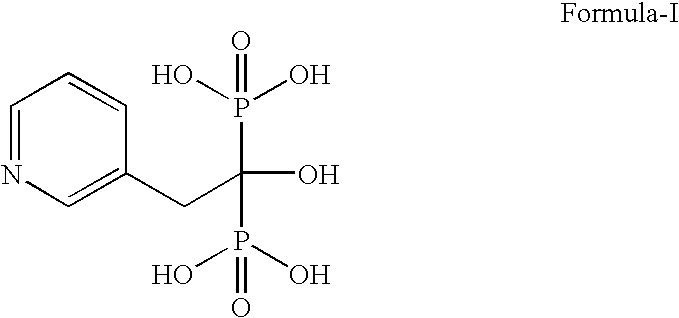Novel Process For Preparing Risedronic Acid
a risedronic acid and process technology, applied in the field of new risedronic acid preparation process, can solve the problems of low yield, inability to disclose operation, and process inability to large-scale applications, and achieve the effect of cost-effectiveness
- Summary
- Abstract
- Description
- Claims
- Application Information
AI Technical Summary
Benefits of technology
Problems solved by technology
Method used
Image
Examples
example 1
A. Preparation of 3-pyridyl Acetic Acid Hydrochloride Salt
[0086]100 gm, 3-pyridyl acetic acid was dissolved in 250 ml toluene and 133 gm, 30% aqueous solution of hydrochloric acid was added at 30-40° C. temperature in 60 minutes. After completion of addition of hydrochloric acid, the temperature of reaction mass was raised to 90-95° C. and the temperature was maintained for 4-6 hrs with continuous removal of water azeotropically. After complete removal of water, the reaction mass was cooled to room temperature (25-30° C.) and the solid was collected by filtration under nitrogen atmosphere followed by washing with 633 ml of petroleum ether. The obtained cake was dried under vacuum at 30-40° C. 120 gm of dried 3-pyridyl acetic acid hydrochloride was obtained.
B. Purification of 3-pyridyl Acetic Acid Hydrochloride
[0087]The obtained 3-pyridyl acetic acid hydrochloride salt (120 gm) was suspended in 300 ml ethyl acetate and the reaction mass was heated to 75-80° C. for 1 hr. The reaction ...
example 2
[0089]3-pyridyl acetic acid (10 kg, 72 mole) was suspended in methyl cyclohexane (72 lit) and phosphorous acid (10 kg, 0.072 mole) in glass lined reactor. The mass was heated to remove water azeotropically. Then orthophosphoric acid (21.53 kg, 0.2414 mole) was added and the reaction mass was further heated to remove more water azeotropically. After complete removal of water, the reaction mass was cooled to 90-92° C. and phosphorous oxychloride (20.93 ltr, 0.2245 mole) was added in 30-45 min maintaining temperature in same range. The temperature was further raised to 95° C. and maintained for 20 hrs. After completion of 20 hrs, water (72 litr) was added and the reaction mass was further heated to 95° C. for 30 min. At same temperature, methyl cyclohexane layer was separated out. The lower aqueous layer was further heated at 95° C. for 5-6 hrs. Now the reaction mass was cooled to 25-30° C. and isopropyl alcohol (72 litr) was added slowly in 30-45 min. Then reaction mass was further co...
example 3
[0090]3-pyridyl acetic acid (100 g, 0.729 mole) was suspended in decalin (800 mL) and phosphorous acid (179.3 gm 2.186 mole) and the mass was heated to remove water azeotropically. Then orthophosphoric acid (215.3 gm 2.419 mole) was added to it and the reaction mass was further heated to remove more water azeotropically. After complete removal of water, the reaction mass was cooled to 90-92° C., and phosphorous oxychloride (209.3 mL, 2.245 mole) was added in 30 min. Then temperature of reaction mass was raised to 95° C. and maintained for 20 hrs. After completion of 20 hrs, water (720 mL) was added in reaction mass and further heated for 30 min. Decalin layer was separated out at 90-95° C. The lower aqueous layer was heated at 95° C. for 5-6 hrs. Now the reaction mass was cooled to 25-30° C. and isopropyl alcohol (720 mL) was added slowly in 30-45 min at 25-30° C. Then reaction mass was further cooled to 5° C. and maintained for 1 hr. The product was collected by filtration and wash...
PUM
| Property | Measurement | Unit |
|---|---|---|
| temperature | aaaaa | aaaaa |
| temperature | aaaaa | aaaaa |
| temperature | aaaaa | aaaaa |
Abstract
Description
Claims
Application Information
 Login to View More
Login to View More - R&D
- Intellectual Property
- Life Sciences
- Materials
- Tech Scout
- Unparalleled Data Quality
- Higher Quality Content
- 60% Fewer Hallucinations
Browse by: Latest US Patents, China's latest patents, Technical Efficacy Thesaurus, Application Domain, Technology Topic, Popular Technical Reports.
© 2025 PatSnap. All rights reserved.Legal|Privacy policy|Modern Slavery Act Transparency Statement|Sitemap|About US| Contact US: help@patsnap.com


